

Art Revue
Mosera stuns with Haiti Earthquake painting, “After Shock”
By Fabian Badejo

The earthquake that has claimed some 200,000 lives in Haiti and left that Caribbean nation in ruins has evoked quite some artistic responses as the whole world rushes in with an avalanche of humanitarian aid. But few artists have captured on canvas, the depth and spiritual dimension of this incredible tragedy as Mosera has done in “After Shock,” an imposing painting that grabs the viewers’ attention for its size as much as for its thematic content and treatment.
Like a mural, “After Shock” dominates the walls of Tropisme Gallery in Grand Case, where Mosera is showing some of his latest works alongside a curious set of African masks from the private collection of entrepreneur and connoisseur, J.C. Huet, who came from Paris precisely to participate in this exhibition titled, “Linkage.”
The masks, generally from East Africa (although a few originate from West Africa), are displayed almost as ornaments, and remain unobtrusive, although their spirit seems to permeate the paintings, imbuing them with a mysterious and ominous air. It is as if they were placed as iconic reminders of Mosera’s artistic roots.
Red is the dominant colour in the about a dozen paintings in this exhibition; perhaps, appropriately so. In this “Red Period” Mosera employs this primary colour as a backdrop that allows his main subjects to stand out in sharp relief. It is also used as a symbol of passion, tragedy, and even of a fiery sunset by the Lagoon. For Mosera, red is the colour of quiet but tortuous contemplation, as in “Contemplator” or even in “Femme sous Grenadiers.” It is the colour of inspiration as in “Muse” and to a lesser extent, in “Violin Player.” Red is also the colour of a peaceful sip of black coffee, as in “Coffee.” All these acrylic paintings, however, combine the three primary colours – red, yellow and blue – in varying degrees, to offer a complete and very striking palette that is as attractive as it is defining.
Nowhere is this combination of primary colours more shockingly effective than in “After Shock,” Mosera’s soulful depiction of the horrors of the earthquake that turned Port-au-Prince into a massive graveyard. Hell could not be more bloody red.
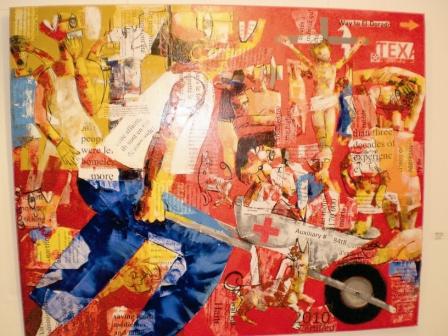 It was Pablo Picasso who once said, “There are painters who transform the sun into a yellow spot, but there are others who with the help of their art and their intelligence transform a yellow spot into the sun.” In “After Shock,” Mosera has transformed the grief, the pain and sorrow, the harrowing, nightmarish Armageddon of Haiti’s apocalyptic earthquake, into a statement of solidarity and universal empathy just as Picasso himself transformed the ugliness and barbaric carnage of the Spanish Civil War into Guernica, his most celebrated anti-war painting.
It was Pablo Picasso who once said, “There are painters who transform the sun into a yellow spot, but there are others who with the help of their art and their intelligence transform a yellow spot into the sun.” In “After Shock,” Mosera has transformed the grief, the pain and sorrow, the harrowing, nightmarish Armageddon of Haiti’s apocalyptic earthquake, into a statement of solidarity and universal empathy just as Picasso himself transformed the ugliness and barbaric carnage of the Spanish Civil War into Guernica, his most celebrated anti-war painting.
Almost every face in “After Shock” is turned skywards, as if asking the heavens “why?” It is a question that the whole world is still pondering as the survivors are caught in that region between life and death where suffering stifles hope, where each breath is an unsure step out of the clutches of the grave into the stench of survival. “Why?” “Why, Lord?” The survivors cry, mouth agape, tears and sweat dried up on their mask-like, awe-stricken faces.
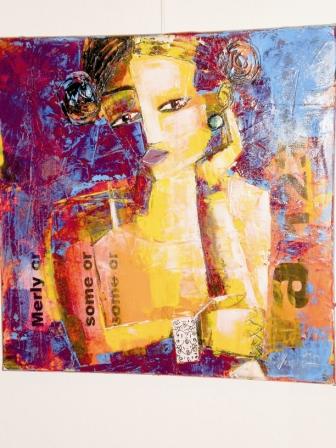 At one end of the canvas, a man seems to be holding his private part with one hand, as if to reassure himself that he has not been castrated, while with the other he clutches a cellular phone to his ear, screaming into it for help or simply informing some distant relative that he’s alive.
At one end of the canvas, a man seems to be holding his private part with one hand, as if to reassure himself that he has not been castrated, while with the other he clutches a cellular phone to his ear, screaming into it for help or simply informing some distant relative that he’s alive.
At the other end, is the figure of Christ nailed to the cross, with the text “Way to El Dorado” floating nearby, while we read the incomplete name of “Texas” with the logo of oil giant, Shell, affixed in the lower left-hand corner of this signboard. This should not be seen as a fortuitous, disjointed reference in view of reports of the alleged involvement of big oil in causing the earthquake. As wild and “off the hook” as such allegations might sound, the magnitude of the tragedy goes beyond human comprehension, thus requiring that our imagination be stretched beyond all known limits.
The main figure in “After Shock” is a tall, sinewy, man, pushing a wheel-barrow as an ambulance full of injured, dying and dead victims of the earthquake, the only siren being his anguished wailing and the unrestrained howling of tearful dogs. Interspersed with newspaper clippings in both English and French, apparently to draw us into attempting to decipher the text, the full impact of the painting is however gleaned from a distance. Mosera succeeds in turning Haiti’s tragedy into a personal experience for the viewer, as he tries to make sense out of a hopeless descent into a monumental abyss. We are all in this together; we have all become Haitians in what seems to be end-time.
The other paintings in the exhibition are thematically different, each one bearing the unmistakable imprint of Mosera, an artist who is forcing us to see beyond our mundane existence and interpret reality from a more spirit-filled perspective.
The exhibition is open daily at Tropisme Gallery in Grand Case from 10:00am to 1:00pm and from 5:00 until 9:00pm and continues through tomorrow, February 21, 2010. It is a must see for all lovers of art.
Copyright February 2010 by Fabian A. Badejo.
Angelo Rombley, the “Pixel Pusher” of St. Martin first digital art exhibition
by Lasana M. Sekou
 Angelo Rombley, senior graphic specialist, digital artist (2005).
Angelo Rombley, senior graphic specialist, digital artist (2005).
Rombley is a leading member of the new generation of St. Martin artists that includes Drisana Deborah Jack, Sundiata Lake, and Loic Bryan.
With a growing body of creative and commercial work well positioned in public view, this group, certainly those mentioned above, could be characterized by being in their 30s but mostly in their 20s; all developed their interest, seminal skills, and love for art in St. Martin; they are mostly university-trained in art; work professionally in the commercial and fine art field; use mixed media, multimedia, and digital technology to create a fine art that is imbued with and expressive of increasingly fascinating stories of their own milieu and of the St. Martin nation. It is not an exaggeration to place Rombley and the group he belongs to among the leadership of the “new generation” of artists. They are not one-hit wonders.
In fact, their work continues to garner popular, professional, and scholarly attention at home and abroad (Jack opened the island’s 2005 cultural calendar on January 15 as the MLK lecture series guestspeaker — linking art to nation building and self-esteem in the youth — at the Chamber of Commerce Building in Spring, Concordia; Bryan followed a day after with his first solo art exhibition at the new Bearden gallery in Simpson Bay; and US literary reviewers appear unable to ignore Rombley’s digital art when they should be focusing on the text of the literati such as Kamau Brathwaite and Amiri Baraka in whose books the artist’s art pieces appeared in 2000 and 2003).
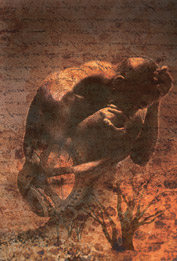 “The rising.” Digital Illustration by Angelo Rombley (2003).
“The rising.” Digital Illustration by Angelo Rombley (2003).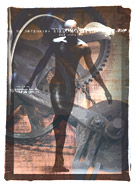 “Me and the machines.” Digital Illustration by Angelo Rombley (2003).
“Me and the machines.” Digital Illustration by Angelo Rombley (2003).
The artist once described himself as “a mild mannered graphic designer by day and the ‘tacky art’ fighter by night, continuing the eternal commitment of ridding the world of bad design and color combinations. “But seriously,” he confides, “I am exploring the infinite possibilities of life and art and where it can take me.” As a commercial artist with over 10 years of experience in advertising, having worked on jobs for companies such as Bellsouth, Disney, andthe University of Miami, Rombley traveled to St. Martin and closed 2004 with a HNP digital art workshop/lecture on December 28, at the UTS Multipurpose Room in Great Bay (Philipsburg).The workshop attendance surpassed the artist and organizer’s expectations. A few people turned back at the door because the room quickly filled to over-capacity.
As Rombley lectured and demonstrated his computer-generated visual craft, school-age children and corporate executives were content to sit on the carpeted floor when all of the chairs were filled with attentive participants. In February 2005, Rombley returned to his homeland to showcase 15 unique pieces of his art. It was the island’s first digital art exhibition and held in Marigot at the Artists’ Corner. Among the 80-odd guests were a few art collectors who appeared to relish being part of “a first” of its kind exhibit and bought a number of pieces. Even more guests bought copies of the limited prints of the originals. The originals are handsomely, richly framed and rendered in the Gigcle´e process on canvas paper. The size of the “paintings” range from 11.5” x 17” (1963, 2002) to 36” x 36” (The Last Tree in Freetown, St. Louie, 2005). The Last Tree … sold for nearly US$2000.
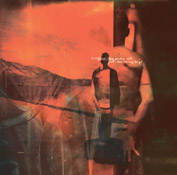 “Standing still.” Digital Illustration by Angelo Rombley (2003).
“Standing still.” Digital Illustration by Angelo Rombley (2003).
By the way, even in this little story, there is place of purpose for the exercise of St. Martin’s traditional unity, which, though far more beleaguered of late, still defies the obscene fact that the 37sq. mi. island is in this day and age a colony of France and The Netherlands. The Digital Art Exhibition & Workshop was a micro project funded by SUNFED, based in the South. The exhibition venue, facilitated by Culture Commissioner Nicole Piper in the North of the island, is the Artists’ Corner at The Mairie’s, Marigot. The collection created and gathered by Angelo Rombley for his first solo exhibition is called the “Pixel Pusher.”
Joe Dominique – The new St. Martin surprise
Lasana M. Sekou
Painting by Joe Dominique, St. Martin. © Joe Dominique.
Dominique-the-artist was first revealed to the public with his solo exhibition at Carl’s Unique Inn Convention Center on April 16, 2000. The venue, though comfortable, was unconventional enough. Known or unknown artists who want to make a début splash would likely head for the known galleries in Great Bay and Marigot, the respective capitals of the South and North of St. Martin. The artist and his agent Fabian Badejo chose the town of Cole Bay, not known for painters, though it has produced the strongest dose of the island’s theater leadership and in olden times it was the popular throughway between the Southern and Northern parts of St. Martin.
The some 50-odd guests that opened the two-day exhibition viewed a body of about 50 oil, acrylic, pastel and charcoal paintings, and collages — not as sibling pieces but commingling in a curious play and display of light on dark, and light coming out of cool cosmic darks and sometimes comforting but never bland earth tones, dressed in impressionistic sheer, and oozing out a familiar environment of rhythm. It is this heaving interplay that attracts me most. It is not a brooding bleed of contrived light or pretentious brightness in perpetual search of sunlight, but more like an ever-fresh feast long relished by the chef before the guests arrived.
At his best, Dominique’s orchestration of light and colors are like cracks in the universe of the canvas through which the subjects of the paintings are configured to life and recognized by the viewer through a wizard’s display of lines, cuts, dabs and wiggles of paint and chalk. This feature gives Dominique’s work an unexpected afro-oriental opulence on the one hand. The other major sensibility perceived in his work is an impressionistic one, not the least revisionist, but yet reminiscent of Claude Monet and Auguste Renoir. These two features are brought to life by Dominique’s breathing into them an authentic New World Caribbean rhythm.

Painting by Joe Dominique, St. Martin. © Joe Dominique.
The Dominique paintings that exude what I referred to as the afro-oriental opulence are not carnivalesque attempts at elegance nor the Indo-Caribbean metamorphosis of Derek Walcott’s tale of Trinidad’s Felicity getting ready for a Hindu festival — both of which are legit aesthetics for any Caribbean artist. The opulent type hones out of this broad term something close to an outsider trying to capture the mood of light and colors of skin and clothing in the royal halls of Moorish Spain, gracefully illumined by the natural light of evening and the elegant dance of just-lit lamps! The top of the line of this expression is “Woman With a Hat,” collected by a St. Martin businessman before the first set of guests made their first round of viewing at the Cole Bay exhibit. Dominique has repeated this style with a number of portraits of St. Martin women.
What is more fascinating about his opulent style, and maybe a bit disturbing—as art should also be—is that the chalk scratches, slices of light, and human-centric elegance, are not reserved for the beautiful people, but shatter its own proud composure with an iconoclastic overbearing gray and sooty rouge in “Motherly Love.” In this charcoal/pastel painting a mother is feeding three meager children all at once: from her breast, with a spoon from the pot of gruel, and from her love. And she herself is emaciated, impoverished! It is a bleak beauty of a journalist’s story and a former high-ranking government official bought it.
Dominique’s still-lifes are in the mode of Euro-classicism. I won’t pretend to know what period and I don’t think he cares for period art, but think pre-1900. I don’t care too much for his acrylic rendering of “Madame Matisse,” probably because it is too close an imitation of the original but then he insists with non-defensive action that he is no mimic when he renders what amounts to an honor gallery of portraits in this cast. The honorees include Pablo Picasso, Romare Bearden, and then Dominique takes off with a fevered pitch, mixing his opulent lines, the purple and blue strokes and cuts in the vividly mischievous oil/pastel portrait of a senior Cul-de-sac landowner, entitled “Emilio Wilson.”
At the Bearden gallery exhibit on Frontstreet in October/November 2000, Dominique re-introduced us to his collages from Cole Bay and a subsequent show down the street at the ABN-AMRO bank in Great Bay. Here he must have had the perfect Cheshire Cat pose, knowing full well what was in store for his guests. His “Market Vendors” and “Beach Clean Up” are deceivingly simple paste-ups of the small traders and workers of St. Martin’s tourism industry. His signature black and white print slips — first seen in April in “The cubs are in the field,” a collage inspired by the long-poem of the same name, and which read like some afro-centric backdrop of hieroglyphics — become more prevalent. The first set of collages that I noticed show off memorable soft watery light blues, easy finger dabs of shade. His material, other than paint, is flat paper/magazine cutouts, and the images on the paper are the standard fare for this medium. Nothing new, but pleasant. Then at the Windward Islands Bank showing in December, lasting until April 2001, I really noticed “Down by the river (Jamaica)” and “African Odyssey” (both were in the Bearden exhibit). And while Dominique’s rush of forest and the cut-out rock wall could easily agitate a conversation in which the definitive 20th century master collagist Romare Bearden’s name must be heralded, the weight of “Down by the river (Jamaica)” and similar pieces, the chunkier cuts of material, the gushing dimensional depths and rough-rising off the canvas/page that takes us on the river raft ride with the collage’s subjects, or leaves us (like leaves) on the banks if we prefer, is more reggae than jazz and again Dominique is his own man, his own artist.

Painting by Joe Dominique, St. Martin. © Joe Dominique.
One visiting American psychologist bought six collages by Dominique late last year at the Bearden gallery. Dominique’s new exhibit opened in Anguilla at the Frangipani resort on March 24, 2001. At the Bearden showing, the Frangipani’s managing director V. Davis bought “Down by the river (Dominica),” which prompted his invitation to show in Anguilla. No sooner had the Anguilla exhibit got underway when a businessman purchased an oil portrait of the opulent type, entitled “Mary-Ann.” In April, Dominique’s watercolor/charcoal “Court House” and the watercolor “Home Help” was on display in the Dominican Republic with the works of better known St. Martin painters Roland Richardson, Ras Mosera, and Cynric Griffith in a tour de art, a caravan of Caribbean artwork that is touring the region.
Badejo refused to give me an in-depth comment on Dominique’s work, probably to let me fend for myself through the possible meanings and place of this new St. Martin “collection.” The most that he uttered was some intellectually-sounding rumble from his throat about “variety and experimentation” as what impresses him most about Dominique’s art. What impresses me the most is that this is the first time in a long time that I am deftly impressed not only by a new painter, but also by a new body of artwork that is already sizable, truthful, indeed varied. And beautiful.
© 2001 Lasana M. Sekou.
About the Author. Lasana M. Sekou is the author of some 10 books of poetry, short stories, and political essays. The James Michener Fellow was editor of the St. Martin Newsday from 1984 to 1997, during which time he wrote regularly about St. Martin, Caribbean, African-American, and African history, culture, literature, theater, art, and liberation movements. The poetry of the St. Martin author and reviews of his work have appeared in Caribbean, American, and European literary journals. Sekou appears regularly in the Caribbean, the USA, and Europe performing his dramatic verse and addressing conferences—the most recent of which was Poetry Africa 2001 in South Africa. His books and author’s profile can be found at www.houseofnehesipublish.com.
Roland Richardson – St. Martin’s most prolific painter
Fabian Badejo
The only thing constant in life is change, and nothing changes with such swiftness as light. Capturing that changing light has been the leitmotif of the French impressionists, particularly of the Monet School and of Roland Richardson, especially in his first period of painting, easily ranking him among the most accomplished impressionists in the Caribbean. Richardson was born on May 18, 1944, in Quartier D’Orleans (part of French Quarter), an area of St. Martin marked by undulating hills, lush green fields where flamboyant trees stood out proud with their red crowns, and where the sun bathed the land with pristine warmth. French Quarter was an impressionist’s dream. One of the most beautiful districts of the island, it has a pastoral atmosphere which must have made the young artist very sensitive to nature in a special way.
 Roland Richardson at work painting the Flamboyant. Well known for his masterful oil paintings of St. Matin’s national tree, Roland has made the Flamboyant or “July Tree” an iconic must for every artist to attempt to draw. (Photo: M.Deigo Van Der Landen, courtesy R. Richardson)
Roland Richardson at work painting the Flamboyant. Well known for his masterful oil paintings of St. Matin’s national tree, Roland has made the Flamboyant or “July Tree” an iconic must for every artist to attempt to draw. (Photo: M.Deigo Van Der Landen, courtesy R. Richardson)In this first period of his artistic life, Richardson explored all the facets of his talent. He painted landscapes, still life and portraits. The edenic beauty surrounding him inspired him. He did etchings, a technique he has mastered so well that few artists in the region today can match his artistry. Some of those etchings, especially of old plantation houses and stone bridges, are the only pictorial account we have of an era that has been toppled by tourism. Whether in oil or pastel, in etchings or charcoal drawings, Richardson distinguished himself as an artist with profound preoccupations about the nature around him and about the people of his native island. This twin concern would soon spur him into social action. The once withdrawn artist would now use his increasing fame at home and abroad to try to change the way people saw and how they behaved in a world in which they had very little control. He got involved in the promotion of culture and tourism. He showed his own paintings in exhibitions at his home and introduced several artists from St. Martin and from other parts of the world to the island in shows held especially at the Poisson D’Or Restaurant in Marigot.
The flamboyant tree had already captured Richardson’s imagination from the very onset of his career. This national symbol of St. Martin became for Richardson not just a symbol of the mystical powers of light on our lives, but also a strong, enduring source of energy which he has raised to near mythological heights. The flamboyant is to Richardson what the sunflower was to Vincent van Gogh. He paints it with a passionate obsession that has forced us to see the tree in a new light. This second phase of his career offered up some major exhibitions of his works at the Maho Beach Hotel and at La Samana in St. Martin, and in Curaçao, the USA, France, and The Netherlands. His painting now acquired a vibrancy of color, which added a more Caribbean touch to them. But Richardson does not like to be pigeonholed. He prefers to see himself as an artist, not as a French impressionist or a Caribbean impressionist.
 Richardson (L) and wife Laura (2nd from L, foreground) with Lt. Governor and Mrs. D.L. Richardson (center) and guests at a Roland Richardson gallery exhibition, Marigot, 1997. (Courtesy R. Richardson).
Richardson (L) and wife Laura (2nd from L, foreground) with Lt. Governor and Mrs. D.L. Richardson (center) and guests at a Roland Richardson gallery exhibition, Marigot, 1997. (Courtesy R. Richardson).
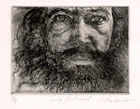 Image to the right: Self Portrait. Etching by Roland Richardson. Private collection. © Roland Richardson.
Image to the right: Self Portrait. Etching by Roland Richardson. Private collection. © Roland Richardson.
In recognition of his achievements as an artist and cultural worker, Richardson became the first artist to be named The St. Maarten Guardian newspaper “Person of the Year” (1993). His Leonardo da Vinci-style beard makes him instantly recognizable, and his wide brimmed farmer’s felt hat, now a trademark of his wardrobe, serves to shield him from the scorching sun as well as to place him in the field among ordinary laborers. Indeed, Richardson sees his paintings as work — a labor of love, a labor of life.
© House of Nehesi Publishers. Excerpt from St. Martin Massive! A Snapshot of Popular Artists, House of Nehesi Publishers (2000). www.houseofnehesipublish.com. Book available at www.amazon.com
Deborah Drisana Jack – St. Martin’s pioneer abstract painter
Deborah Drisana Jack was born in Rotterdam, The Netherlands in 1970 — a descendant of the Bell klan from Cole Bay, St. Martin, one of the Caribbean island’s oldest traditional families. Having spent her formative years growing up in St. Martin, she considers herself a St. Martin/Caribbean artist, “Not only in terms of geography but in terms of cultural/spiritual location.” Her current work deals with identity, trans-cultural existence and the effects of colonialism of the physical and psychic landscape. Her focus is on constructing a history based on ancestral memory, in opposition to the hierarchical construction of Western dominated history. Drisana uses a variety of media, such as video, painting and sound art/poetry.
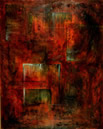 |
 |
 |
| L-R: Saltpainting 3, by Deborah Jack; Flora I. 2002. Color photograph or a (C-print) (15”x19”) by Deborah Jack; Creation . 2001. Oil/canvas (24”x30”) by Deborah Jack. © Deborah Jack. | ||
In 1995, Drisana represented the Territory of the Netherlands Antilles at CARIFESTA VI in Trinidad & Tobago in Visual Arts and Drama. In 2002, her artwork was selected to represent St. Martin in Cuba’s Festival del Sol in 2002. In 1997, the same year in which her first book of poems The Rainy Season was published, Drisana and several other art activists founded Axum Art Café. Though short-lived, this “hot spot” quickly became a cornerstone nurturing ground and gathering place for the nation’s avant-garde musicians, poet, singers, dancers, visual artists and intellectuals.
Deborah Drisana Jack completed her master’s in fine arts (MFA) at the State University of New York (SUNY) at Buffalo, where she has received several grants and fellowships, including the SUNY College of Arts and Sciences Dissertation Fellowship. In 2002 she became a Fellow of the International Photography Institute when she was selected to participate in its National Graduate Seminar. She is a member of the Evolutionary Girls Club, an artist collective that considers itself a response to the “old boy network” and fosters support amongst its members. Drisana’s work has been exhibited and screened in solo and group shows in St. Martin, Tallahassee, Florida, Cuba, Ukraine, Trinidad & Tobago, Germany, Finland, Buffalo and Rochester, New York; and prized by St. Martin’s private collectors and art lovers.
© Offshore Editing Services. For more about Drisana Deborah Jack see St. Martin Massive! A Snapshot of Popular Artists, House of Nehesi Publishers (2000) and The Rainy Season, House of Nehesi Publishers (1997).
go to: Literature & Fiction
go to: About the authors
Books available at www.amazon.com
“Warmed seawater raised in offering/ a vortex/ rain. a salted rain …”
Drisana Deborah Jack
There is an inner space that bears witness to what eyes have not seen, ears have not heard and what the head and heart deny. In this place lies the archeology site of memory, buried under years of images, sounds and countless units of trivial bits & bytes of mis/dis-information. With this constant inundation of “stuff,” how does one find time to make connections, the kind of connections that form memories? How does one find the space to excavate, to create a sacred space for homage to ancestral memory?
In her novel Beloved Toni Morrison introduces the concept of “Re-memories,” that “memory that flashes up in the moment of danger.” I have adopted the concept of the re-memory and relocated it from a supernatural space and into a natural one, or perhaps a hybrid of the two. My re-memory occurred on September 5, 1995, while waiting for a catastrophic level hurricane to hit my Caribbean island of St. Martin. With sustained winds in the area of 180 mph and an almost nonexistent eye, destruction was not a question, just the level of it.
Warmed seawater raised in offering/ a vortex/ rain. a salted rain. down on our heads. a violent Cyclops, at the center is the eye; it is the calm center, the focus, the pause. a rupture with in the rupture, cocooned by the strongest winds, the roughest seas. It is the miracle, the tempest of memory within the anesthesia of anti-memory.
 |
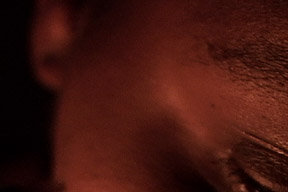 |
 |
|
Visual art by Drisiana Deborah Jack. © Deborah Jack.
|
||
Satellite images and computer-generated maps flash on the screen and I see I see the Atlantic connecting the coast of Africa and the Americas. In the center, the churning tempest, the Middle Passage. Now the natural space becomes a political space. Nature becomes the catalyst for political thought and art becomes the environment where this can happen.
The inspiration for my current work centered on the idea of Atlantic hurricanes, as symbolic representations of the souls lost during the Middle Passage who come in a seasonal ritual of remembrance and renewal, assaulting us with salted rainwater, coating the islands with salt. This is the salt that literally and symbolically coats my paintings. The monochromatic photo images are manifestations of blood-memories, who like the salt are part of the residue of violence.
As a multi-media artist I deploy video/sound installation as a strategy for mining sites of cultural memory. The delivery is subtle, deliberate and relentless creating a visual/ aural landscape opening a sacred space for the viewers to experience their own re-memory. My concerns are that of creating a mythology for a culture on the brink of political independence, however it is a culture that is becoming increasingly disassociated from history and heritage mainly due to the effects of colonialism past and present.
What happens to lives lost in senseless violence? Are there voices in the wind? Is the storm a reckoning? Is the salt meant to erode, and eat away at the layers cultural amnesia, and therefore re-birthing them? This is my re-memory, my counter-mythology to the hegemonic myth of History.
There is cause and effect and then there is the echo.
The resulting crime of the institution of slavery is the dis-membering of the histories, cultures, traditions, families, and personal memories of a people: a trend that for me is mirrored today by the tourism industry. I am interested in seducing the eye through the “lush and exotic” space of the imagined space of the Caribbean and insist upon an integration of a political analysis. It seeks to articulate an historical, cultural, racial injury in a way that tries to avoid and subvert images of suffering and victim-hood that have been used as visual hot buttons in the past. I am attempting in my own way, as a result of my own re-memories, to re-member.
Loic Bryan’s St. Martin “Unity”

The above digital art by Loic Bryan is entitled “Unity” (2006) and was featured in Fête – Celebrating St. Martin’s Traditional Festive Music (2008). The content and media of the artwork is a modern representation of the historic striving for a unity in St. Martin* that overcomes the French/Dutch colonial division between the North and South of the island. The Unity Flag (wrapped around standing figure), is also known as the cultural flag or “National Flag” of St. Martin. (The other two figures in the artwork are wrapped respectively in the French flag (L) and the flag to date of the “Territory of St. Maarten.”) The unity banner represents the people, land, and culture of the whole island, North and South. (see the book National Symbols of St. Martin) Loic Bryan is a multimedia artist who has been steadily building his portfolio of illustrations, photographs, digital art, and graphic design. The St. Martin artist belongs to a new generation of artists who design publications and whose works appear regularly on book and magazine covers and in exhibitions.
* “St. Martin” is the traditional spelling for the entire island.
© 2011 House of Nehesi Publishers.
St. Martin sculptor Theodore Bonev

“Lady Liberty” at the Agrement roundabout, St. Martin
MARIGOT/GREAT BAY—The “Lady Liberty” statue at the Agrément roundabout is probably the best-known public sculpture by Theodore Bonev in St. Martin.
“The stunning beauty and elegance of Lady Liberty” was unveiled in 2007 to mark the 159th anniversary of the 1848 Emancipation from slavery. www.thedailyherald.com
Sculptor Benev’s work can be found at other locations, at the West Indies Mall in Marigot and on tombstones.
 The St. Martin sculptor has also exhibited abroad. His “Caribbean Woman,” another elegant statue with sensuous curves, is on permanent display at the Changchun World Sculpture Park in China.
The St. Martin sculptor has also exhibited abroad. His “Caribbean Woman,” another elegant statue with sensuous curves, is on permanent display at the Changchun World Sculpture Park in China.
Bonev was awarded the bronze medal for the statue, which was sculpted in China as a feature of the 9th annual China Changchun International Sculpture Symposium (CCISS) in 2008. Over 40 countries participated in the CCISS.
“The piece I created for the CCISS was a representative of the Caribbean woman with all her beauty and style,” said Bonev in an interview in October 2008, with Shujah Reiph, producer of the Conscious Lyrics radio magazine.
About the Authors
 Marion Bethel is a poet, short story writer, essayist and attorney from The Bahamas. A Cambridge University graduate, Bethel’s writings have appeared in Callaloo, The Massachusetts Review, … Read more
Marion Bethel is a poet, short story writer, essayist and attorney from The Bahamas. A Cambridge University graduate, Bethel’s writings have appeared in Callaloo, The Massachusetts Review, … Read more
 Free copy with all HNP orders … While supply last
Free copy with all HNP orders … While supply last
Fete – Celebrating St. Martin Traditional Festive Music
A special culture features publication, song, music, dance, carnival, and more, 48 pp.
Contents: Foreword • Tanny & The Boys • Bèbè recalls • In a fête • Quimbé • Carnival • “Jim Tucker” Samuel • Ray Anthony Thomas Tale of a concert • A blast in The Netherlands • Ponum • A bumper crop • Eat, drink …

